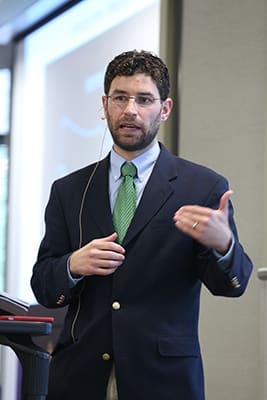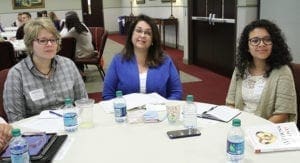 Photo By Michael Alexander
Photo By Michael AlexanderSmyrna
Local parish leaders gain insights on reaching millennials
By ANDREW NELSON, Staff Writer | Published April 6, 2017 | En Español
SMYRNA—Nearly everyone has a smartphone, which has become the new cathedral, the center of culture, a repository of memory, an expression of identity, in addition to being a wonder of technology.
Speaking in the archdiocese on March 30, some scholars from Notre Dame University questioned if these touchscreen gadgets are creating a hunger in digital natives that experiences of faith may satisfy.
People now increasingly desire individuality and authenticity and it can be century-old customs of the Catholic faith that appeal to this generation.

Brett Robinson, Ph.D., from the McGrath Institute for Church Life at the University of Notre Dame, was one of three presenters during the session for parish leaders. Here he conducts a presentation on “Markers of a Digital Culture.” Photo By Michael Alexander
“Catholicism is an incarnational religion. Technology is dis-incarnational,” said Brett Robinson, of Notre Dame University’s McGrath Institute for Church Life.
While communities can be formed virtually, there is a difference between resending a Twitter message and encountering someone face to face.
“It’s the bodily practice that forms the bonds,” he said.
Indeed, Father Gaurav Shroff, a parochial vicar at St. Andrew Church, Roswell, said the parish can be a place for restless young adults to be grounded. It is important to respond to the need created as technology flourishes.
“There is a sense of loss of humanity. We have to re-educate ourselves how to be human,” he said.
‘Seeking understanding and how-to’s’
More than 100 ministry leaders from across the archdiocese spent Thursday, March 30, focused on young adults and the church. In a program organized by the Office of Formation and Discipleship, scholars from the McGrath Institute shared insights on women and men who grew up in the digital age, so-called “emerging adults.”
The Notre Dame speakers presented in broad strokes the cultural tides shaping the lives of the millennials, from the rise of the digital age to the search for authenticity of this generation, who now outnumber baby boomers.
Retaining Catholic millennials, the generation born between 1981 and 1998, is increasingly difficult. Fewer people in their 20s and 30s are interested in the Catholic Church. The Pew Research Center in 2014 found only 16 percent of millennials called themselves Catholic versus 23 percent of baby boomers. As the group approaches the marriage age, that sacrament is dropped, too. Marriages in the church in the United States between 2010 and 2016 fell 13 percent, reported the Center for Applied Research in the Apostolate at Georgetown University.

(L-r) Martha Robert, director of religious education at St. Jude the Apostle Church, Sandy Springs, Rosana Szvarca of the St. Jude the Apostle Church Brazilian community and Kathy Guerrero, the youth minister at Immaculate Heart of Mary Church, Atlanta, participate in a table discussion on reaching out to young adults in the digital age. Photo By Michael Alexander
Amy Daniels, the director of the Office of Formation and Discipleship, said the large turnout shows church leaders can see how fewer women and men are coming to the church for marriage or bringing their children to be baptized.
“The parish leaders are very concerned and have a great desire to reach out and connect and integrate the young adults into the life of the parish. They are seeking understanding and how-to’s,” she said.
The next step is for the McGrath Institute to review information from young adult focus groups held that evening and then compile the findings for parishes in the archdiocese. The results and recommended practices will be tools to be used.
Church tradition as counterweight to digital age
The millennial generation grew up with the breakneck pace of the digital age. But the speed of the scroll of the Facebook News Feed can mean a “lack of ability to have a sabbath of the mind,” Robinson said.
And church leaders are suggesting technology isn’t neutral but promotes a world-view that “mutates culture,” said Robinson. He quoted Pope Francis’ encyclical “Laudato Si’” where the pope questions whether technology has a role in “shaping social possibilities along the lines dictated by the interests of certain powerful groups.”
In response, an offering of church practices can be a counterweight. Parish processions and candlelit Eucharistic adoration can touch young people as an authentic experience of faith for those who have never experienced them, Robinson said.
Notre Dame itself saw the opportunity in technology to get ancient practices of beliefs in front of the eyes of the digital natives. It developed a smartphone app, 3D Catholic, which reminds people on their phone to pray at a certain time, what fasting means and creative ways to do it, and concrete ideas for serving others. The “3D” is for three devotions: prayer, fasting, almsgiving.
Drawing on traditions for a new generation
Timothy O’Malley, an expert in liturgy from the McGrath Institute, said most young people who leave the church fall out of practice, as one missed Sunday Mass turns to two or three and then becomes permanent.
In the past, people may have left the church for a time but often returned at life’s milestones, he said. That practice is over; people leave and don’t come back, he said.
“We are in a new era. Not an evil era, a new one,” he told the room filled with church workers. “It’s not a radical hatred. It’s ‘I am OK without it.’”
What can root people in the church are emotional experiences that are also linked to the church’s ancient history, he said.
Protestant megachurches with emotional worship have found over time people don’t commit to the community, he said. Catholics should instead match opportunities for heartfelt worship with traditions from the church’s past.
“We need practical practices to ground people,” he said.
There is a deep well of practices and devotions that respond to people’s desire to live authentic lives, he said. Believers have an experience not found in the digital realm by putting themselves in the midst of fellow Catholics, he said.
Students see lives of authenticity
Conference-goers left affirmed and also challenged to serve this generation where they are on their faith journey.
Paula Scotran, of St. Lawrence Church, Lawrenceville, said her parish has a vibrant youth program, but participation drops off as people reach their teenaged years.
“We have to listen carefully to what they have to say,” she said.
Joandra Ocampo, a millennial at 23 and a youth minister, said the suggestions from the speakers echo what St. Mary’s Church, Rome, is considering for outreach. The goal isn’t to serve people with emotional experiences but a connection to the Catholic Church through Jesus, she said.
Phillip Thompson, executive director of the Aquinas Center of Theology at Emory University, said university students are always amazed at one of the most austere traditions of the church, the life of monks at the Trappist monastery in Conyers.
“They love talking to the monks. What they see in the monks is a form of authenticity they often don’t see in the world around them,” he said.
Churches need to continue reaching believers at different stages of life, he said.
“Doing something different isn’t denying the fundamental truths. It makes the truths of the faith attractive for a new generation,” he said.